
Quick search for private accommodation
History & Culture
Meet the city with 2300 years of tradition. It's rich culture is created under the influence of old Greeks, Romans, Venetians. Trogir with concentration of palaces, churches, towers, fortress on a small island in aevery way deserves it's nickname "THE STONE BEAUTY"TROGIR (TRAGURION)
was settled by the Greeks in IV-III century BC during theirs hunts across Mediterranean.In the First century AC, Trogir became Roman municipality "TRAGURIUM CIVIUM ROMANORUM" joined to Salona, center of Roman province of Dalmatia. Upon the fall of the Roman Empire in Fifth century, Trogir has been developed as a independent town.
In the Sixth century, the Croats settled in Trogir area and began creating works of art. Right from the beginning of the Middle Ages the old Greek town of Tragurion felt the fire of the new medieval culture. Builders and masons built churches and decorated it with interlaced ornamentation.
During the Tenth century citizens of Trogir renewed they old municipal life of the formal Roman "oppidum". In their struggle against the Venetians, the kings of Hungary got Trogir to their side in return for a guarantee of Independence. Its citizens could freely elect their city leaders and, already in the Eleventh century, the small community crowded on the fortified islet, had its own Bishop who was suffrage of the Bishop of Split.
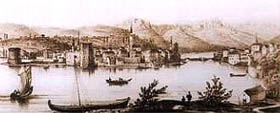

At the beginning of the 13th century, while they were still recovering from the raids of the Venetians, who had attacked them in 12th century during their war with Hungary for the attractive Dalmatian coast, Trogir citizens under Rector Ilija from the Kacic family built their new cathedral. Forty years later, RADOVAN carved its main portal in Seget stone.
Prospect of Trogir was brutally interrupted 1420. when town was occupied by Venetians after long struggle, and it was badly devastated. Occupation lasted for almost four centuries, until 1797. During that time, Trogir was rebuild again and many new palaces, houses, towers and fortresses were erected. After short period of independence, Trogir had fallen under Napoleon's domination which was remembered by significant communal and health - care reforms, and modernization of economy.
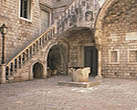

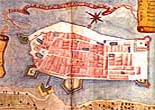
Austrians conquered town one more time (1814 - 1914) when citizens suffered illness, epidemics and hunger. After 1848, process of democratization started, and very shortly, 1877, Croats were rulers in their town. After First World War, Trogir, together with Croatia, became a part of State of South Slovenes, but agony of hunger and indigence wasn't finished.
Real improvement of standard and the way of life started in 1970-ies when Ship industry and tourism were employing more then 50% of Trogir citizens. Further development was interrupted by aggression on Croatia 1991, when people of Trogir and its economy suffered serious consequences. Ongoing integration processes in European Community started with UNESCO's acknowledgement of Trogir as a World cultural Heritage in 1997. Now, on the beginning of the new Millennia, Trogir becomes popular tourist destination as it was in '80-ies.

The relief of Kairos the Greek god of the happy moment
probably from the 1st century B.C., is kept in the Benedictine nunnery with the church of St. Nikola. Discovered in Spring 1928 in a abandoned house of Stanosevic family.The Greek inscription from the 4th - 3rd century B.C., the oldest written monument in the area of Trogir, is also built in the wall of the cloister of this nunnery. The Kairos Story
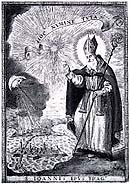
St. John of Trogir
(Sv. Ivan Ursini), patron of the town - on sketch from XVll century. His monument is erected on the North Town Gate, northern entrance in old Trogir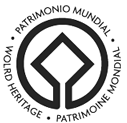
UNESCO - World Heritage Committee
decided to inscribe Trogir with the following description:"Trogir is a remarkable example of urban continuity..."
Read complete text
Site seeing in Trogir:
TOWN MUSEUMPlaced in old part of Garagnin - Fanfogna palace, takes You on the voyage through Trogir rich history.
Opening times:
From: 16/09-14/06 on call, 08:00 (8 am) till 14:00 (2 pm)
From: 15/06-15/09, daily from 09:00 (9 am) till 21:00 (9 pm)
Tickets: adults: 10kn, children & groups: 5kn
CHURCH ART COLLECTION AND OLD BENEDICTINE NUNNERY COLLECTION
Near South town gate, attached to St. Nicolas Church.
Opening times:
From: 15/06-15/09, daily from 08:00 (8 am) till 13:00 (1 pm) and from 15:00 (3 pm) till 19:00 (7 pm)
Tickets: adults: 10kn, Children & groups: 5kn
FORTRESS KAMERLENGO
Venetian defense citadel on western part of Trogir island.
Opening times:
From: 15/06-15/09, daily from 09:00 (9 am) till 20:00 (8 pm)
Tickets: adults: 10kn, children & groups: 5kn
ST. LAWRENCE CATHEDRAL BELL-TOWER
47m high tower with magnificent view over old Trogir and the area.
Opening times:
From: 15/06-15/09, daily from 09:00 (9 am) till 12:00 (Noon) and from 16:00 (4 pm) till 19:00 (7 pm)
Tickets: 5kn








